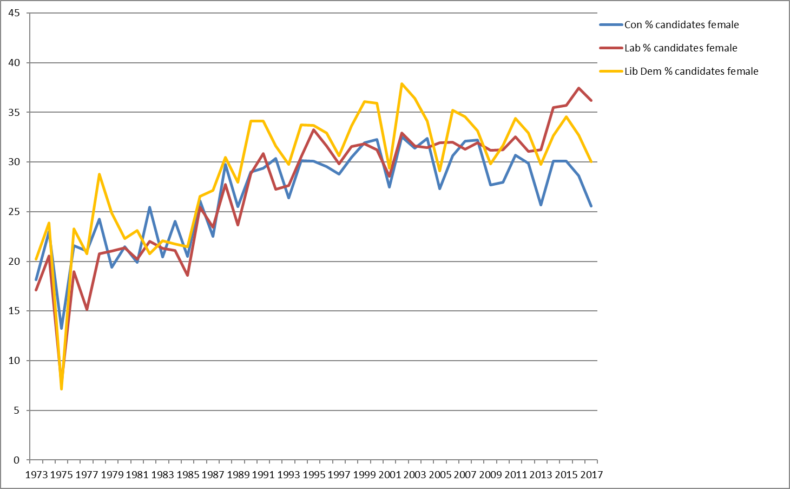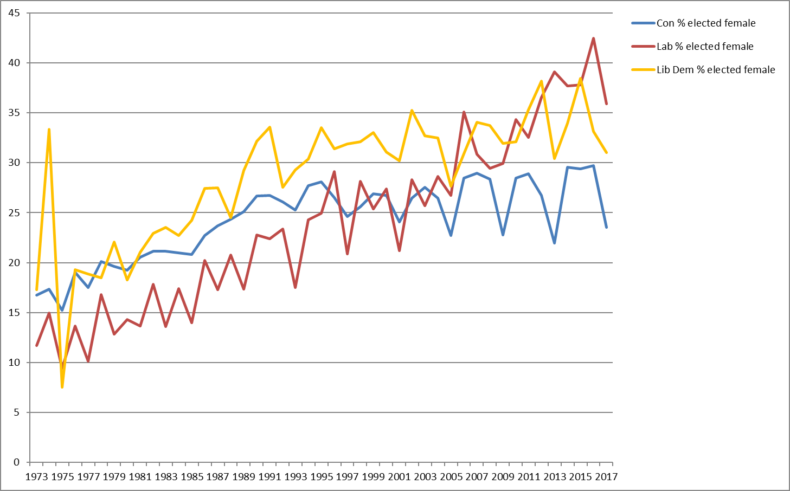Stalled: Lib Dem gender balance in local government
A little belatedly, it’s time for the 2017 version of my annual post about the gender balance amongst council candidates and councillors in the big May round of elections.
Diversity isn’t only about gender, of course, but it is the strand for which there is a long-running data series stretching back to the early 1970s. That’s important because there are regular and predictable fluctuations in the gender balance across the cycle of different sorts of council elections – and hence the longer term trend is the important thing to keep an eye on.
The 2017 figures continue the recent pattern: the long run of improving Liberal Democrat gender balance amongst candidate up until earlier this century stalled well short of parity and there is now even a slight slipping back. For councillors, the picture is very similar, for although it looked like there might have been another step forward a few years back it too has now faded away. The contrast with Labour’s pattern is telling as Labour used to consistently under-perform the Liberal Democrats and now, after having taken deliberate and significant moves, Labour does consistently better.


As to why these figures matter, it’s for three main reasons. First, it matters if you think politicians should in some way be representative of the public they seek to represent. I’m all for some differences. I’d quite like our politicians to be a bit more interested in politics than the average punter, for example. But this goes well beyond that.
Second, having predominantly white, male, able-bodied and middle class candidates could be ok if you think that’s where the talent and ability really rests in the population. But if you think the rest of the population have something in those stakes too…
Third, and last because it’s a more insular point, having a candidate line-up that is even less diverse that the party’s membership points to a party failing to make the most of the talents of its members. That would matter for any party, but all the more so for a party that is still just one bad general election result away from extinction in the House of Commons. Hence the importance given to improving our diversity in the new Liberal Democrat strategy.
Be a Liberal Democrat councillor
Know anyone who might make a great councillor? Thinking of it yourself? Here’s a great guide to give some ideas and encouragement.
Lib Dem gender balance in previous years
- 2016 Lib Dem gender balance
- 2015 Lib Dem gender balance
- 2014 Lib Dem gender balance
- 2013 Lib Dem gender balance
- 2010 Lib Dem gender balance
- 2009 Lib Dem gender balance
- 2008 Lib Dem gender balance
- 2007 Lib Dem gender balance
Thank you once to Colin Rallings and Michael Thrasher of The Elections Centre at the University of Plymouth and authors of British Electoral Facts 1832-2012 for providing the data used in this post.
Why the dip in Lib Dem and Con female candidates ever 4 years (the county council cycle) but not Labour. Or more interestingly why has that stopped with Labour (which suggests somethign can be done to alter that)
The dip every four years coincides with the all up London elections. The demographic in London is younger than in the rest of the UK. More effort should be made to recruit young female candidates. The Tower Hamlets party has proved it can be done – no excuses!
Hi Julia I think you are mistaken (tho it’s not easy to tell from the graph). The dip is cyclical on county council elections. I’m guessing the 2018 data isn’t available yet.
I’ve suggested on Twitter some of the institutional reasons why that may be the case. The contrast with Labour is interesting. There are some institutional reasons why it might be easier for Labour to find women candidates for county council seats but that doesn’t explain change in relative performance between them and Lib Dems in 2017.